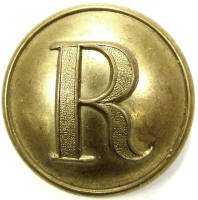
A virtual examination of artifacts of the American Civil War
 |
Ridgeway Civil War Research Center, A virtual examination of artifacts of the American Civil War |
| Civil War Artillery | |
| by Harry Ridgeway |
| Rifled artillery projectile, James design, Federal manufacture, bursting shell, "common" (standard), open base with slots, lead and tin sleeve sabot, tie ring base, James percussion fuze, James 14 pounder rifle, 3.8in. Projectile was manufactured in the Federal arsenals following the invention of Charles James. The pattern utilized a hollow caged cavity (called a "birdcage") covered by a thin sleeve of lead , tin , and canvass, the thin sabot would expand into the rifling, and then be discharged after the projectile left the bore. This meant that there always be flying metal debris which could be a problem for forward troops . Four small holes were drilled into the base, these are thought to have been vent holes, however they are often lead filled. A ring around the base was originally installed to hold an iron cup, however it appears the iron cup may not have been used and the tie ring either was abandoned or used to secure the powder bag. Shell is common shot (does not contain balls) and with percussion fuze was designed to be used against opposing cannon by striking the equipment . Fuze employed was the James brass anvil percussion fuze, "West Point" two part fuze, Jones pg. 30 . Projectile measures: diameter 3.7in., length 6.75in. weight 10lbs , with sabot. Research Center: Artillery4424-James, Ref: Dickey & George, Field Artillery (1993 Edition), pg. 189. Details click: http://relicman.com/artillery/Artillery4424-James.html. |
| Ridgeway Civil War Research Center, A virtual examination of artifacts of the American Civil War. Artillery Research center, artillery, click: http://relicman.com/artillery/Artillery0000-Index.html. Research center, artillery, click: http://relicman.com/artillery/Artillery0000-Index.html. |
| Civil War Relicman, Harry Ridgeway, Civil War artillery, Relicman sales catalog. Click here: http://relicman.com/artillery/RelicmanSalesArtillery1.html. Artillery for sale: http://relicman.com/artillery/RelicmanSalesArtillery1.html. |